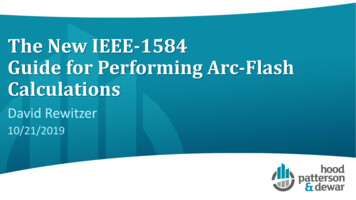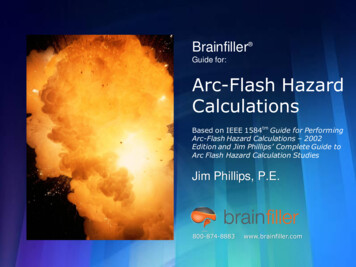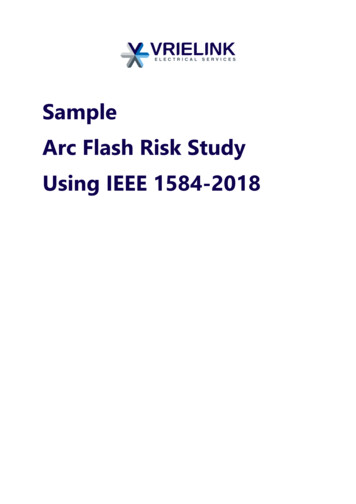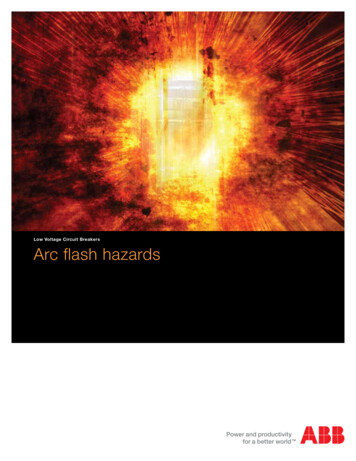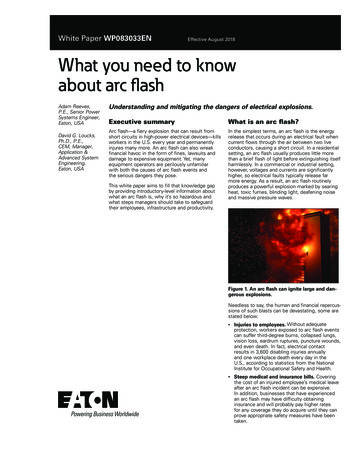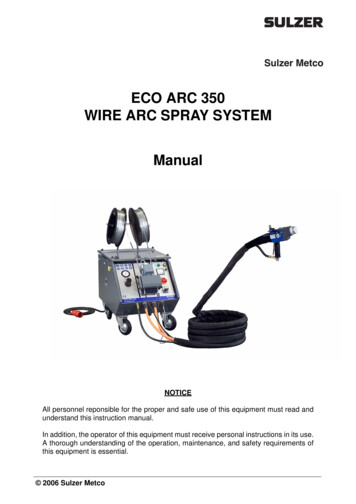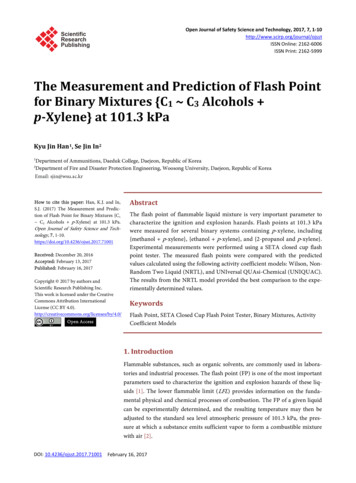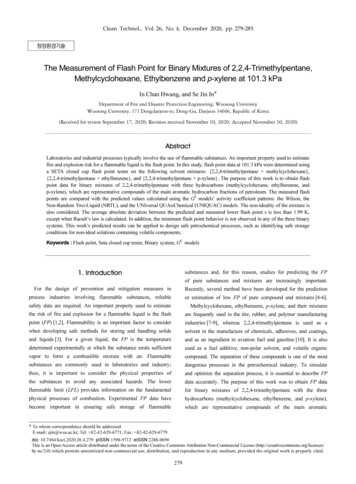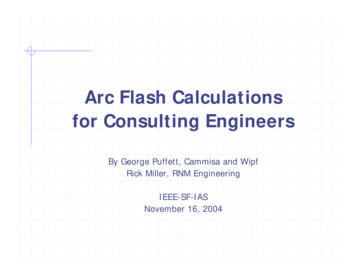
Transcription
Arc Flash Calculationsfor Consulting EngineersBy George Puffett, Cammisa and WipfRick Miller, RNM EngineeringIEEE-SF-IASNovember 16, 2004
OutlineHistoryHazardCodes & StandardsCalculationsEnforcement
HistoryShock / Electrocution Major HazardRalph Lee 1982 “The Other Electrical Hazard: Electric ArcBlast Burns”Electrical Arc Burns Are a Common InjuryElectrical Arcing is Term Applied to CurrentPassing Thru a Vapor of ConductiveMaterialEstablished Relationship BetweenTemperature and Skin Burns & HumanTissue Cell DeathIEEE 1584 Expanded Lee’s Work
Recent Local IncidentStanford UniversityTechnician injured at linear accelerator-Ulysses TorassaThursday, October 12, 2004A technician suffered second and third degree burns Monday after a 480 voltelectrical arc erupted during the installation of a circuit breaker at the StanfordLinear Accelerator Center, authorities said.The man, who was not identified, was installing the device at 11:18 a.m. next to anelectrical panel in a section of the 2 mile long accelerator located just west ofInterstate 280, said center spokesman Neil Calder.The arc ignited his clothes and threw him backward, but two co-workers who werenearby were able to put out the flames quickly. He was being treated in theburn unit at Santa Clara Valley Medical Center in San Jose.Calder said officials had suspended operations at the accelerator for a few dayswhile the accident is investigated but that the halt was unlikely to affect anyresearch work.SFGate.com
Hazards of Electrical WorkElectrical Shock – Direct ContactElectrical Shock – Vaporized Metal in ArcPlasmaArc Flash Burns (Heat, Fire)Arc Blast (Pressure, Shrapnel, Sound)Secondary hazards includeFallsFire
Photos of Arc Flash Hazard
Photos of Arc Flash Hazard
7:30am Nov. 8, 2004 in SFVaporizedcopper
Arc Flash Hazard ComparisonSteam (water to vapor) (Heat ofVaporization) at 212 F.Vaporized copper at 5000 F.
Arc Flash Hazard ComparisonSkinDuration of DamageTemperature ExposureCaused110 F6 Hours158 F1 Sec.Cell breakdownbeginsTotal cell destruction176 F0.1 Sec.Curable burn200 F0.1 Sec.Incurable 3rd degreeburns
Flash Hazard AnalysisA Flash Hazard Analysis must beperformed before a person approachesany exposed electrical conductor orcircuit part that has not been placed inan electrically safe work condition.The Flash Protection Boundary willestablish the need for PPE to cross thatboundary.Flame Resistant (FR) clothing andPPE are used by the employee basedupon the incident energy associatedwith the task.
Alternate Methods of AnalysisMethod 1: NFPA 70E TablesMethod 2: Calculations per formulas inNFPA 70E based on available faultcurrent and fault clearing timeMethod 3: Calculations per formulas inIEEE 1584, based on empirical testdata.
Definitions of Key TermsIncident EnergyFlash Protection or Arc Flash BoundaryLimited Approach BoundaryRestricted Approach BoundaryProhibited Approach BoundaryQualified PersonWorking Distance
National Electrical CodeArticle 110.16 Flash ProtectionSwitchboards, panelboards, industrial controlpanels, and motor control centers that are in otherthan dwelling occupancies and are likely torequire examination, adjustment, servicing, ormaintenance while energized shall be field markedto warn qualified persons of potential electric arcflash hazards. The marking shall be located so asto be clearly visible to qualified persons beforeexamination, adjustment, servicing, ormaintenance of the equipment.FPN No. 1: NFPA 70E-2000, Electrical Safety Requirements for Employee Workplaces,provides assistance in determining severity of potential exposure, planning safe workpractices, and selecting personal protective equipment.FPN No. 2: ANSI Z535.4-1998, Product Safety Signs and Labels, provides guidelines forthe design of safety signs and labels for application to products.
Sample Label
IEEE & NFPA
NFPA 70E - 2004Energized Electrical Work PermitDescription of equipment and workJustification of why work energizedDescription of safe work practicesShock Hazard Analysis & ApproachBoundariesFlash Hazard Analysis & FP BoundaryProtective clothing and PPERestriction of unqualified personsJob BriefingManagement approval
Sample Energized Work Permit
DefinitionFlash Hazard Analysis: A studyinvestigating a worker’s potentialexposure to arc-flash energy, conductedfor the purpose of injury prevention andthe determination of safe workpractices and the appropriate levels ofPPE. [from NFPA 70E 2004]
Hazard Category ClassificationTable 3-3.9.1 Hazard Risk Category Hazard Risk Category (0 to 4) Voltage Rated Gloves (Yes or No) Voltage Rated Tools (Yes or No)Table 3-3.9.2 Protective Clothing & PPE Protective Clothing and Equipment Hazard Risk Category Protective Systems for Category (-1to 4)
NFPA Table 3-3.9.1
NFPA Table 3-3.9.2
Protective Clothing & PPEUntreated Natural Fiber (not synthetic) T-shirt, Long-sleeve shirt, PantsFR Clothing [by employee per NECA]Long-sleeve shirt, Pants, Coverall, JacketFR Protective Equipment [by employer per NECA]Flash suit jacket, Flash suit pants, Hardhat, FR hard hat liner, Safety glasses,Safety goggles, Face protection, Hearingprotection, Leather gloves, Leather boots
Flash Suit
Safety PolicyIt is the policy of the Company to provide safe and healthful workingconditions by acknowledging safety as the highest of priorities in all ofour work activities. Knowledge of the job, the hazards involved, andthe precautions to be taken are all critical factors in preventingaccidents. It is our continual goal to eliminate occupational injuries andillness among our employees.It is the goal of the Company to have employees properly trained to meetthe standards of a “Qualified Person” as set forth by OSHA (US) andOHSA (Canada) and to provide continual improvement of ouremployee’s job skills and safety awareness through training andcommunication of vital safety information.Employees should never feel pressured to work in unsafe conditions ortake unnecessary risks by working on equipment, which introducesadditional or increased hazards.While the Company is committed to providing safe and healthful workingconditions for each of its employees, in return the Company expectsand insists that each employee recognize their obligation to conductthemselves in strict accordance with our safety policy and with dueregard not only for their own safety but for the safety of their fellowemployees, sub-contractors and customers as well.
Prerequisite to AnalysisOne-Line DiagramShort Circuit StudyCoordination Study
Concept of CalculationVoltage, Current, Time“Flash Protection Boundary Calculation”:DC (2.65 x MVABF x t)1/2DC distance in feet for 80 FMVABF bolted fault at point involvedt time of arc exposure in seconds[from NFPA 70E, Part II, Appendix B]
Concept of CalculationVoltage, Current, Time“Flash Protection Boundary Calculation”:DC (53 x MVATR x t)1/2DC distance in feet for 80 FMVATR rating of transformer(For 0.75MVA multiply by 1.25)t time of arc exposure in seconds[from NFPA 70E, Part II, Appendix B]
IEEE 1584 CalculationsEmpirically derived formulas based onyears of testing at four recognizedtesting laboratoriesArcing current is calculatedIncident energy is calculated usingarcing current and arcing timeEquations tailored for specific protectivedevices – fuses or circuit breakers andampere rating
IEEE 1584 Formulas
IEEE 1584 Formulas
IEEE 1584 Formulas
IEEE 1584 Formulas
How to ComputeSlide calculator [from fuse manuf.]Look-up Table [from NFPA 70E]Spreadsheet using IEEE 1584 formulas,included with the standardComputer program
Slide Calculator
Example Computer Programs
Sample One-Line Diagram-BF
Sample One-Line Diagram-AF
Sample One-Line Diagram-AFB
Sample One-Line Diagram-IE
Sample Short Circuit Study
Sample Coordination Study
Sample Arc Flash Results-1
Sample Arc Flash Results-2
Sample Arc Flash Results-3
Sample Arc Flash Results-4
EnforcementENGINEERSNEC 2002, Art. 110.16California Electrical Code 2004 based onNEC 2002 Published early 2005Effective 180 days later 2005EMPLOYERSOSHA 1990 recognizes NFPA 70E as anational consensus standard
Obligations and OpportunitiesENGINEERSPerform Arc Flash AnalysisEMPLOYERSComply with OSHA and NFPA 70E
The End
16.11.2004 · IEEE 1584 Expanded Lee’s Work. Recent Local Incident Stanford University Technician injured at linear accelerator-Ulysses Torassa Thursday, October 12, 2004 A technician suffered second and third degree burns Monday after a 480 volt electrical arc erupted during the installation of a circuit breaker at the Stanford Linear Accelerator Center, authorities said. The man, who was not identified .
